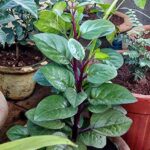Growing eggplant in a pot is an ideal way to enjoy the vegetable in your own home. Eggplants are an amazing vegetable that can be grown in a variety of locations, including pots. Growing eggplant in a pot allows you to have easy access to the vegetable, and can be done in a variety of climates.

When growing eggplant in a pot, you will need to choose a pot that is at least 12 inches deep and 12 inches wide. It is important to choose a pot that is larger than this as the eggplant will need plenty of room to grow. The pot should be made of a material that is porous and allows water to drain freely. It is also important to ensure that the pot has drainage holes at the bottom.
You will also need to choose a soil that is suitable for eggplant. It is important to choose a soil that is rich in organic matter and has good drainage. An ideal soil for eggplant is a blend of peat moss, compost, and perlite. This will ensure that the eggplant has the best possible environment for growth.
When planting your eggplant in a pot, fill the pot about halfway with the soil mixture and then water it thoroughly. Once the soil is damp, you can plant the eggplant seedlings. Make sure to space the seedlings evenly and be sure to press the soil around them firmly. After planting, water the soil again and then place the pot in an area that receives at least six hours of direct sunlight each day.
Once the eggplant has been planted, you will need to provide it with adequate water. Eggplant needs to be watered regularly, but it is important not to overwater it. Eggplant is sensitive to overwatering, so it is important to make sure that the soil remains slightly moist. You can check the soil by pressing down on it with your finger. If the soil is still moist, it is best to wait a day or two before watering it again.
Once the eggplant has been established, it is important to fertilize it. You can do this by using a slow-release fertilizer that is specifically designed for eggplant. The fertilizer should be applied once every two weeks to ensure that the eggplant has an adequate supply of nutrients.
As the eggplant grows, it will need to be pruned. Pruning helps to keep the plant healthy and encourages new growth. It is important to prune back any dead or diseased branches and to also remove any branches that are growing too thickly.
Growing eggplant in a pot can be a great way to enjoy the vegetable in your own home. With the right pot and soil, you can enjoy the taste and nutrition of eggplant all year round. By following the tips outlined above, you can ensure that your eggplant plant will be healthy and productive.




















